Ciovacco Capital Management, LLC is an independent financial advisor based in Atlanta, Georgia. Helping investors cope with the new reality of a flat world, CCM helps individual investors, large & small, achieve improved investment results via research and globally diversified investment portfolios. Since we are a fee-based firm, our only objective is to help you protect and grow your assets. Our long-term, theme-oriented, buy-and-hold approach allows for portfolio rebalancing from time to time to adjust to new opportunities or changing market conditions. When looking at financial advisors in Atlanta, take a hard look at CCM - Financial Advisor Atlanta.

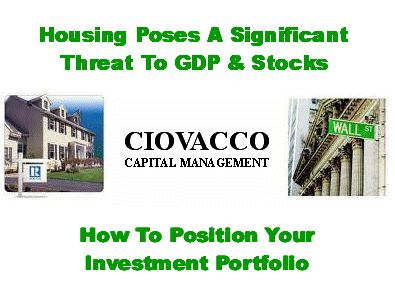
Page 2 of 2
Return to Page 1
September 19, 2006
The Current Environment - Similarities & Differences To 2000-2002
Since housing is such an important contributor to our economic well being, it is safe to assume that the Federal Reserve will attempt to engineer a soft landing just as it did after the Tech bust began in 2000 (read the Fed will lower interest rates). With the current readings of inflation, it is also safe to assume that any rate cutting campaign may have to be shorter in terms of calendar days and lesser in terms of degree. The Fed will have trouble taking rates as low as they did in the last economic slowdown since lower interest rates tend to feed inflation. While the next rate cutting cycle may look different and the global economic picture is different than it was in 2000, we can still benefit from reviewing economic and investment trends from 2000 to 2002.When global investment markets peaked in early May of this year, we did not have as much evidence of a possible future economic slowdown as we do today. For example the NAHB's Homebuilders Index was still above 50 as of April 30, 2006, which means builders were split about 50-50 on the outlook for housing the next six months. As a result, there were much better odds in May that the investment landscape would remain similar to the one that had been present in the last 12 months (commodities strong, emerging markets strong, etc). That is no longer the case.
Commodities and emerging markets did rally off their June lows, but that rally may be in jeopardy as market participants have more fully embraced that the economy is slowing. The market's recent interest in more economically sensitive issues seems to have some questionable circular logic. Here is my read on what the stock market is forecasting in the next 6 to 12 months:
- Slower economic growth which will lead to...
- A reduction demand for commodities such as oil (this makes sense)
- Lower oil prices mean more discretionary spending and a stronger than expected economy (or a less severe slowdown)
But, doesn't a stronger than expected economy or a less severe slowdown mean that the demand for commodities (mainly oil) will also be stronger than expected? If so, doesn't that eventually take us back to where we were in early May with a strong economy fueling the demand for commodities, which in turn is helping fuel inflation?
The economic evidence seems to suggest:
- Slower economic growth - maybe slower than many are prepared for in terms of their investment allocation. It seems the stock market has underestimated the probable negative impact of housing on economic growth
- A slowdown in the demand growth rates for oil and commodities in general, but not a move to negative growth rates or a reduction in demand from present levels for any significant period of time. The more likely outcome is that energy demand growth rates will remain positive, but experience a slowing in their positive rate of growth. For example, if you assume energy demand is growing at an average annual rate 2.4%, we may see that figure soften to a growth rate of 1.7% per year during an economic slowdown. With billions of new people in Asia moving to a more energy intensive lifestyle, it is hard to forecast declining demand for energy for any significant period of time. In terms of investment, energy and commodities still appear attractive long-term, but they may not perform well in the next 12 to 18 months as the markets price in a slowing economy. Whether or not demand for commodities really slows significantly, the important thing here is that the perception is that the demand will slow. After a bull market correction, which could be significant, commodities should benefit from a continued expansion of credit and the money supply (especially if the Fed is forced to lower rates sometime in the next 3 to 9 months).
- More persistent inflation than the markets have currently priced into stocks. An inverted yield curve (when a 2-year CD pays the holder more interest than a 5-yr CD) has historically produced above average short-term inflation pressures. There is also a meaningful correlation between government spending and inflation. Inflation is more prevalent in periods where the government spends more then it collects. This is the situation that we have today.
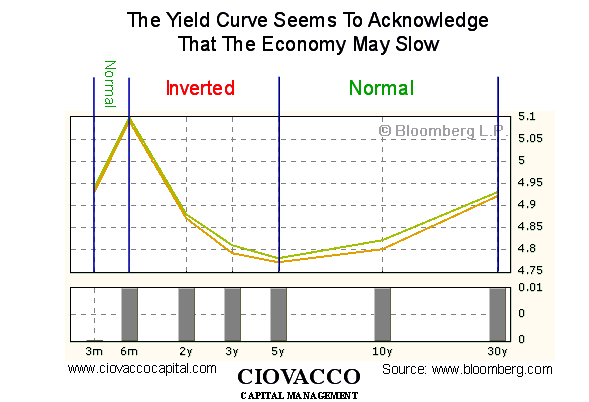
- A possible return to stagflation which was last experienced from 1973 to 1982. Stagflation is a period of above average inflation rates accompanied by slower economic growth (see charts below). During the previous stagflationary period, commodities significantly outperformed both stocks and bonds.
- Below-average, inflation-adjusted returns for U.S. stocks. Stocks may rise in nominal terms, but vs. gold, the world's true currency, the returns may not be significant.
- More persistent inflation than the markets have currently priced into stocks. An inverted yield curve (when a 2-year CD pays the holder more interest than a 5-yr CD) has historically produced above average short-term inflation pressures. There is also a meaningful correlation between government spending and inflation. Inflation is more prevalent in periods where the government spends more then it collects. This is the situation that we have today.
The charts below help illustrate several important points:
The commodities bull market is most likely not over, but it may experience a significant correction and/or period of consolidation. Both gold and a diversified basket of commodities experienced strong gains from 1972 to 1975, which is similar to what we have seen from roughly 2001 to 2006. While the bull market was far from over, commodities basically went sideways (consolidated) from 1975 to 1977. We can see a similar consolidation in gold during the same period. From 1977 to roughly 1980, the bull market in gold resumed and rewarded investors who better understood long-term market cycles. In a similar manner, a diversified basket of commodities also reverted back to bullish mode from 1975 to 1982
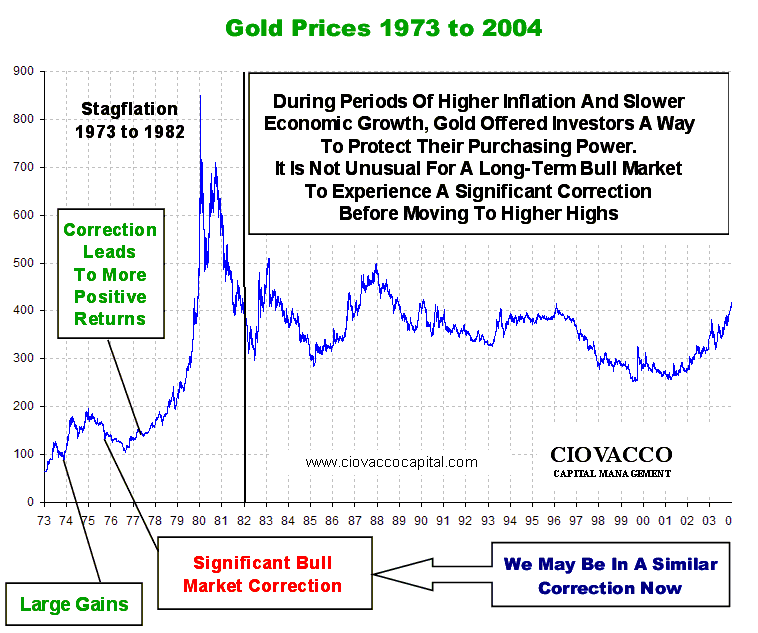
At the present time, it may be prudent to lighten up on some of your exposure to gold. Slowing economic growth and the perception that slower growth always leads to lower inflation (not always the case) will continue to create a period where gold may lose some of its appeal as an inflation hedge. However, as economic weakness picks up and the market begins to sense that the Federal Reserve may be closer to lowering rates, the appeal of gold will again start to increase as investors realize that any lowering of rates by the Fed will increase downward pressure on the U.S. Dollar. The true appeal of gold is that it offers protection from paper currencies that can be debased by governments. We still like gold very much in the long run, but also must acknowledge the case for possible weakness before the next major leg up. As the chart above shows, there can be painful corrections in a long-term bull market.
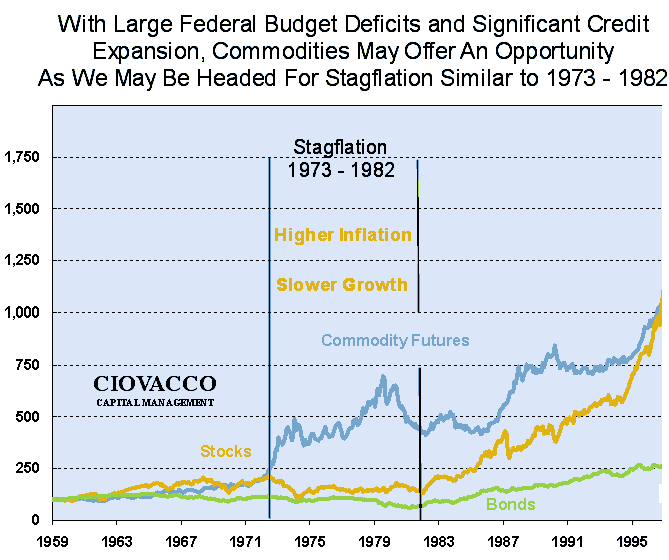
In a similar vein, commodities also remain very attractive on a long-term basis, but they may continue to come under pressure as long as perceptions remain that growth is slowing and the Fed may not be done raising rates. Commodities will become more appealing once the Fed signals that rate cuts may be in the cards. As the chart below shows, much like gold, commodities in general also may experience a period of consolidation before resuming a long-term uptrend.
![]()
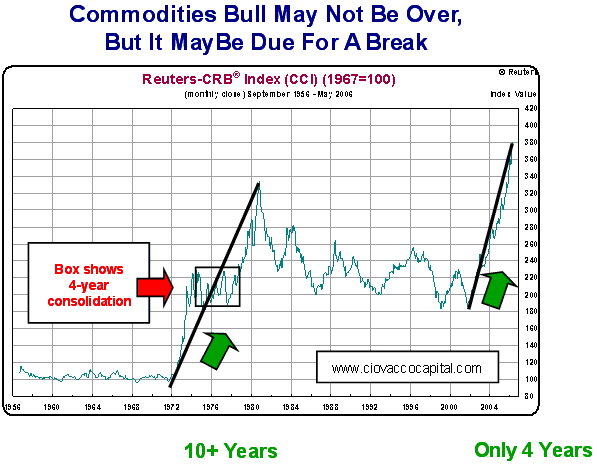
Details Of The Last Economic Slowdown 2000-2002
If we are entering a period of slower economic growth and declining asset prices (housing), we may experience a similar economic and investment cycle that was present after the S&P 500 topped in March of 2000. Stocks did not bottom until October of 2002. In order to become further prepared for economic weakness, I recently took a more detailed look at investment performance from March of 2000 to October of 2002. I broke this period into six sub periods where investors varied their economic outlook from positive to negative and then back to positive again. The phases look at how the financial markets react to moving from economic expansion to slower economic expansion (or recession), and where the Federal Reserve is transitioning from a rate raising cycle to what eventually becomes a rate lowering cycle.Before we make some comments about the charts below, it is important to mention that economic cycles and market reactions rarely, if ever, follow historical patterns in the exact same way (timing, magnitude, and correlations always shift in some way). As an investor, you must balance history with current market conditions and always listen to what the current market is telling you. Said another way, no matter how compelling a bullish or bearish case you have in hand, never stubbornly hold on to any beliefs in the short run. The market may be seeing things that you have missed. Your confidence should rise when your opinion or forecast starts to be confirmed by market activity. It can be very expensive to invest based on what you think the market should be doing vs. what it is actually doing.
Based on my research, I feel we are approaching the end of Phase I. Phase I most likely began in today's market in early May 2006. Phase I in the year 2000 began when the S&P 500 topped in March of 2000. Phase I is a feeling out process where the market is unsure of how much growth is going to slow, and if the Fed is done raising rates yet. You can view all six phases by using this link (click here)
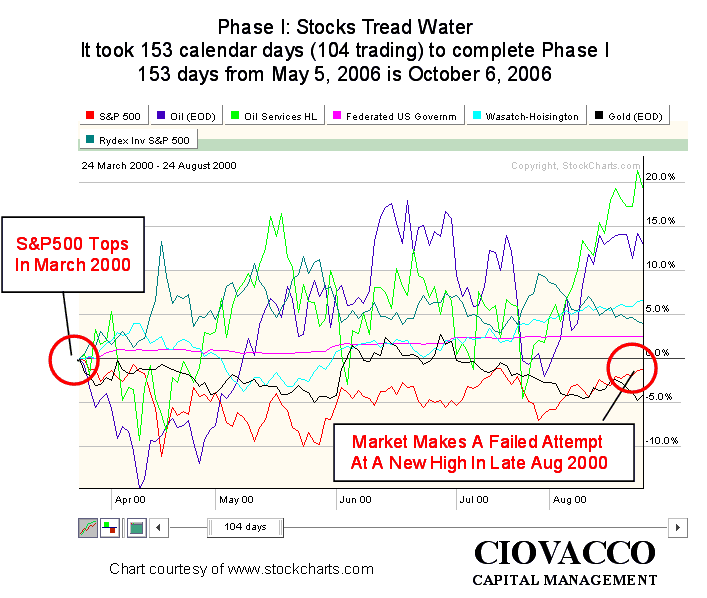
In the year 2000, Phase I took 153 calendar days to complete. In 2006, if we assume that Phase I began on May 5, 2006, then 153 calendar days would take us to October 6, 2006 (roughly two weeks from now). I would not put too much stock into that date, but it tells us that Phase I of the current cycle may be getting close to completing.
Since I believe Phase I is almost over or should complete sometime in the next 30 to 60 days, I want to focus our attention on Phases II thru XI with an emphasis on Phases II and III.
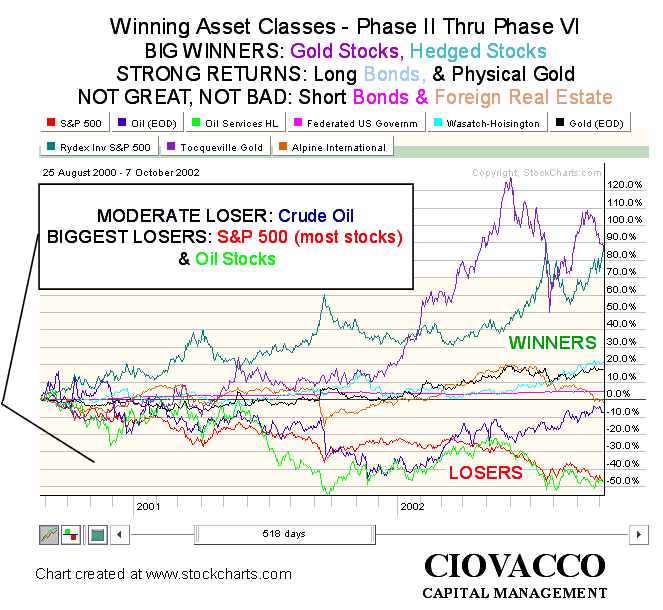
The chart above shows Phase II (once stocks shift to a long-term down trend) to Phase VI (where the stock market bottoms in anticipation of the next expansionary cycle). The winners in the previous economic slowdown where gold stocks, hedged stocks (via options or shorting), long maturity bonds, physical gold, short maturity bonds, and foreign real estate. Since we all hold U.S. real estate, our analysis focused on real estate outside the U.S. The investments that performed poorly during Phase II through Phase VI were most stocks (foreign and domestic), including oil stocks.
If you are wondering how a diversified basket of commodities performed from Phase II to Phase VI, the answer is much better than the S&P 500, but basically flat (it was up roughly 1.04%).
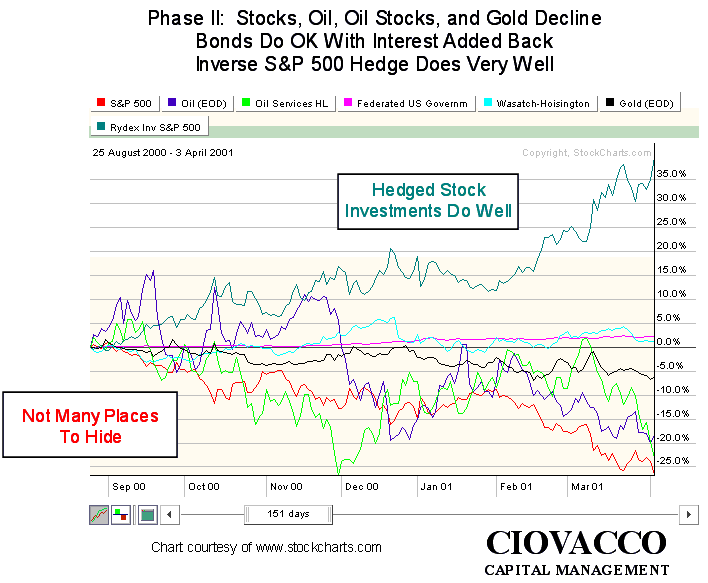
Phase II (chart above) is when the market really starts to acknowledge that the economy is slowing (maybe more than most had planned for) and the odds are increasing that the Fed is done raising rates. Stocks become weak after the focus moves off the Fed and shifts to future corporate earnings and a weakening economy. On the long side, bonds provide some cover, but only short sellers of stocks or those who have hedged stock positions (using options contracts) perform well during Phase II.
We have not yet entered Phase II where stocks have topped, but it is prudent to at least have a plan in place to migrate to should we enter Phase II sometime in the coming weeks or months.
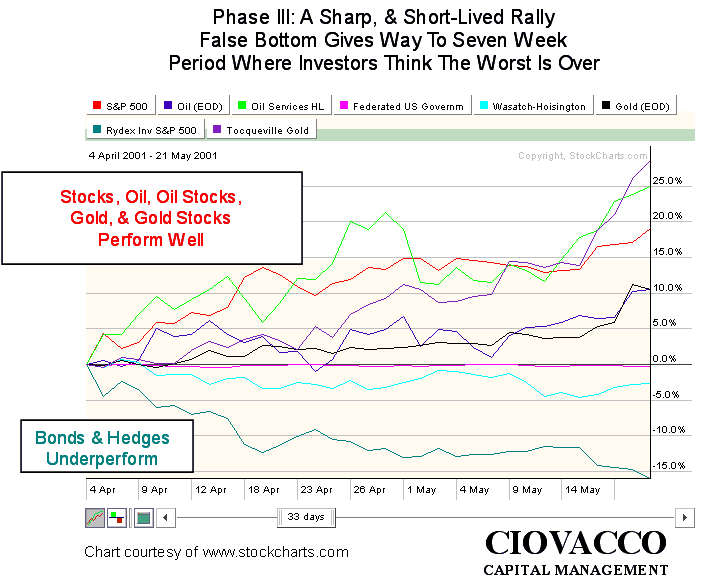
Phase III (see above) shows that even after we have started a downtrend for stocks, there will be several false rallies as stocks continue to make lower and lower lows. You can see all Six Phases of the last bear market by using this link.
The Obvious Wildcard - Inflation
Inflation is the greatest variable that will most likely change the way the current cycle evolves vs. what happened from 2000 to 2002. If inflation is already in check, then the results of the previous cycle will be a more accurate proxy for what may happen in the next 6 months. On the other hand, if inflation continues to be a problem, it may force the Federal Reserve to initiate further interest rate hikes. This scenario would put into question the safe haven status of bonds until the Fed can get inflation under control.
What Does It All Mean?
We are still uncertain if the Fed is finished raising rates or if the major stock market indicies have already made significant highs for the cycle in May of 2006. As a result, it is important to keep an open mind concerning how the next six months may play out. I feel the evidence is compelling enough to begin reducing exposure to assets that did not perform well in Phase II of the year 2000 cycle (shown on charts above). You may also want to increase your exposure to bonds. With the uncertainty associated with the Fed, a mix of shorter and longer maturity bonds may be prudent. Parking some money in a money market may not be a bad idea either. It will give you an opportunity to see how things play out in the next 30 to 120 days while earning an easy 5%. Taking a more conservative view of how gold and a basket of diversified commodities may perform in the next 6 months may also be a good idea. With the government in significant deficit spending mode, inflation may be with us for quite some time, which means a stagflation portfolio may have appeal after Phase II has completed. This may also be an excellent time to consider doing some research on possible ways to hedge your U.S. stock positions. This can be done with options or via selling short. This may take the form of a very small portion of your assets; say 5% to 10%. This small position can help hedge other positions from possible weakness.Chris Ciovacco is the Chief Investment Officer for Ciovacco Capital Management, LLC. More on the web at www.ciovaccocapital.com
Page 2 of 2
Return to Page 1
September 19, 2006
All material presented herein is believed to be reliable but we cannot attest to its accuracy. Investment recommendations may change and readers are urged to check with their investment counselors and tax advisors before making any investment decisions. Opinions expressed in these reports may change without prior notice. This memorandum is based on information available to the public. No representation is made that it is accurate or complete. This memorandum is not an offer to buy or sell or a solicitation of an offer to buy or sell the securities mentioned. The investments discussed or recommended in this report may be unsuitable for investors depending on their specific investment objectives and financial position. Past performance is not necessarily a guide to future performance. The price or value of the investments to which this report relates, either directly or indirectly, may fall or rise against the interest of investors. All prices and yields contained in this report are subject to change without notice. This information is based on hypothetical assumptions and is intended for illustrative purposes only. THERE ARE NO WARRANTIES, EXPRESSED OR IMPLIED, AS TO ACCURACY, COMPLETENESS, OR RESULTS OBTAINED FROM ANY INFORMATION CONTAINED IN THIS ARTICLE.
Ciovacco Capital Management, LLC is an independent money management firm based in Atlanta, Georgia. CCM helps individual investors and businesses, large & small, achieve improved investment results via research and globally diversified investment portfolios. Since we are a fee-based firm, our only objective is to help you protect and grow your assets. Our long-term, theme-oriented, buy-and-hold approach allows for portfolio rebalancing from time to time to adjust to new opportunities or changing market conditions.
Map & Location Info - CLICK HERE